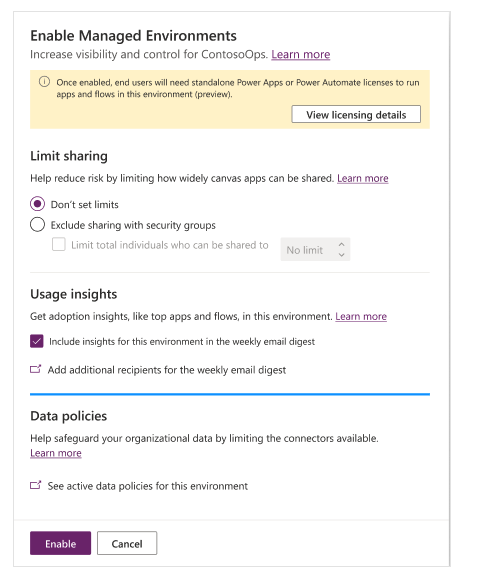Set up environments and data policies
A cohesive environment strategy supported by data policies enables your organization to protect your existing digital assets and securely deploy solutions.
This article will help you and your team get started with:
- Developing best-practice processes.
- Establishing an environment strategy that supports application lifecycle management (ALM).
- Setting up data loss protection (DLP) policies that support SAP integration with Power Platform.
Prepare
Take a couple of preparation steps before developing your organization's environment strategy for Power Platform integration with SAP.
First, make certain that members of your team are assigned admin roles:
- Microsoft Power Platform System admin
- Dynamics 365 Global admin
As an admin, please review Administer Microsoft Power Platform. You can also review Use service admin roles to manage your tenant, Management and monitoring, and Working with the admin portals to gain more insight on how your organization can best secure and manage an SAP + Power Platform deployment.
Next, review your organization's current Power Platform administration and governance practices with your team. Identify strengths and opportunities for improvement. This is also a good time to review Microsoft Power Platform best practices.
More information: Security and governance considerations
Develop an environment strategy
Environments serve as containers to separate applications that might have different roles, security requirements, stages of deployment, or target audiences.
Installing, configuring, testing, and running solutions on Power Platform requires application lifecycle management. A three-environment strategy supports ALM:
- Development: The development sandbox environment is where the SAP Procurement solution template should first be installed and copied so it can be extended to meet your business requirements. This environment is connected to an SAP developer environment.
- Test: The test sandbox environment is where configurations layered on top of the SAP Procurement solutions should be staged and validated by technical and business experts. This environment is connected to an SAP test environment.
- Production: The production environment is where your extended and tested SAP solution for Power Platform goes live so your organization's designated users have access to it. This environment is connected to your production SAP environment.
Note
Each environment requires that a Microsoft Dataverse database be created for it.
More information:
- Establish an environment strategy
- Create an environment in the Power Platform admin center
- Manage Microsoft Dataverse settings
- Microsoft Dataverse developer documentation
Enable managed environments
Managed environments give admins more control when running mission-critical processes—such as your procure-to-pay processes. You can:
- Put tighter controls on accessing SAP data by setting data policies and limiting sharing.
- Get adoption insights by viewing usage.
- Take advantage of other capabilities that support solutions running enterprise scenarios.

Set up data policies
Data loss protection (DLP) policies within environments ensure that data is managed in a uniform way across the organization and act as the guardrails that prevent users from unintentionally exposing organizational data.
The DLP policies you set up ensure that your valuable SAP business data is not accidentally shared to other parts of the business or externally.
Create a data policy that meets your organizational needs and allows the environments targeted for the SAP procurement solutions to have access to the SAP ERP, Microsoft Dataverse, Office 365 Users connections, and any other connections needed to run your procure-to-pay processes.